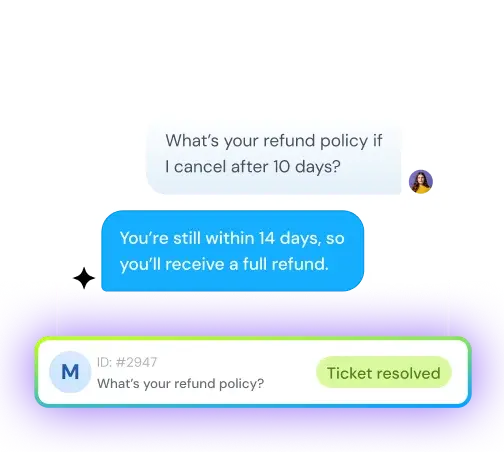The 14 chat support skills that make agents top performers
Sneha Arunachalam
Oct 07, 2025

Imagine this: a customer lands on your website, runs into a problem, and clicks the live chat button. Within seconds, they expect a clear, helpful response — or they’ll leave. No phone calls, no long email chains — just instant help.
Live chat has become the preferred channel for customers, and chat ticket volumes continue to surge year after year. The stakes are high: one slow response, and you risk losing a loyal customer.
So, what separates average chat agents from the top performers in 2025? It’s not just speed — it’s a combination of sharp communication, emotional intelligence, technical mastery, and real-time problem-solving.
In this guide, we’ll break down the essential Chat Support skills that make agents truly excel, from writing clear messages and showing empathy to handling multiple chats at once and using AI-powered tools effectively.
Whether you’re training new agents or leveling up your own support skills, this is your roadmap to delivering fast, human, and memorable customer experiences.
What makes live chat support skills essential in 2025
Customer service has changed — and there's no going back. The old playbook of phone-first support doesn't match what customers actually want anymore.
The shift to digital-first customer service
Here's what happened: customers, especially younger ones, decided they'd rather solve problems themselves than wait on hold. This "self-service or no service" mentality isn't just a preference — it's how entire generations approach getting help.
Digital customer service offers two things customers care about most: speed and convenience. They want answers now, and they want them available whenever they need help. Miss those expectations? They'll find someone who won't.
Today's support spans email, live chat, social media, and more. But this isn't just about having more channels — it's about meeting customers where they already are. The smart move? Make sure your systems talk to each other so customers don't have to repeat their story every time they switch from chat to phone.
Why live chat is now a primary support channel
We already know customers want fast responses, but here's something that might surprise you: 63% now pick live chat as their primary support channel. That's not just convenience talking — it's about getting real help without the hassle.
Chat support requests have skyrocketed in recent years. Why the sudden surge? Simple. Customers figured out they could:
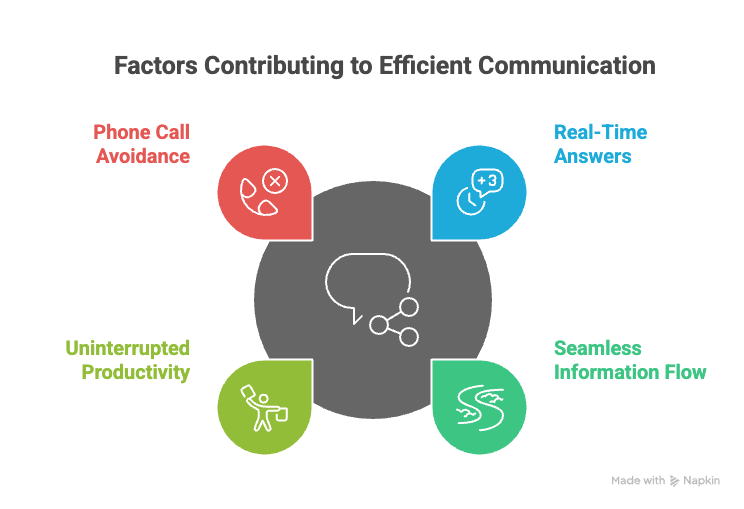
- Get real-time answers to their questions
- Keep doing other things during the conversation
- Skip the phone call entirely
Here's the thing about customer patience — one in five will abandon you if your chat support moves too slowly. The tech industry gets this right, with chat satisfaction rates hitting 87%. That success comes from understanding that immediate help beats perfect help every time.
The role of chat agents in customer retention
Good chat agents don't just solve problems — they build relationships that keep customers coming back. When agents understand what customers really need and provide solutions that fit, trust follows.
The business impact is hard to ignore. Companies using live chat see:
- A 48% boost in revenue per chat hour
- Conversion rates reaching 40%
- 60% of customers more likely to buy again
But here's what really matters:Customers say live chat makes them want to return to a website. That's the power of making someone feel heard and valued in real-time.
Chat agents today wear multiple hats. They're problem-solvers, sure, but they're also sales partners who spot upselling opportunities and retention specialists who keep subscriptions active. The best ones make it feel natural — helpful rather than pushy.
Email and FAQ pages can't create the human connections that live chat does. When customers feel that connection, chat support skills become the foundation for relationships that last well.
Core communication skills every chat agent needs
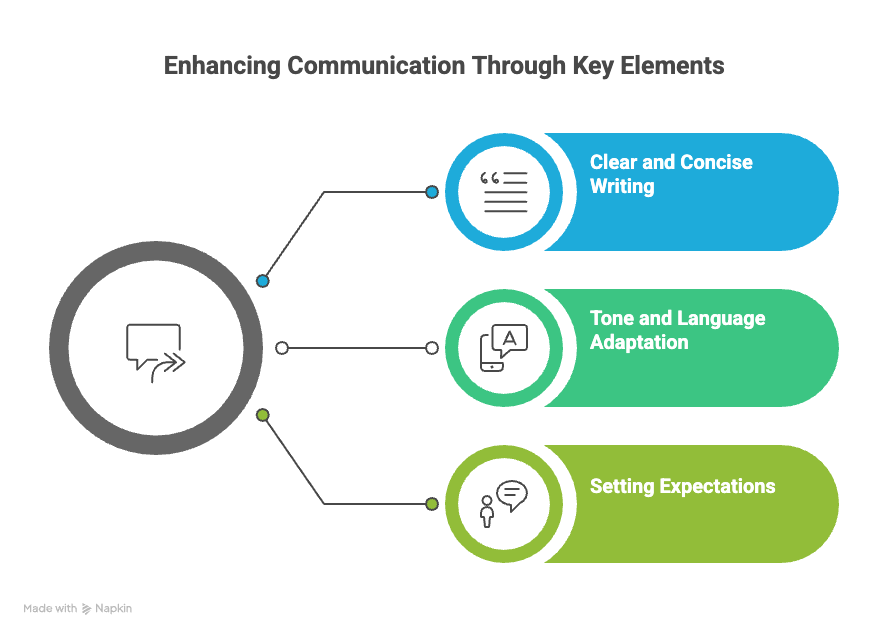
Here's the thing about chat support — you're building relationships with nothing but words on a screen. No voice tone to help you out, no facial expressions to smooth things over. Your written words have to do all the heavy lifting.
1. Clear and concise writing
Chat customers want answers, not novels. When someone types a question, they're looking for a quick, straightforward response — not three paragraphs of confusing text that makes them work harder to find what they need.
Keep it simple. Use everyday language that any customer can understand. Skip the technical jargon unless you're absolutely sure they know what you're talking about. What seems obvious to you might be completely foreign to them.
Your messages need to be brief. Research shows that text taking longer than 20 seconds to read often gets overlooked. Here's what works:
- Keep chat messages to two sentences or less
- Break down complex steps into bullet points
- Double-check your grammar and spelling before hitting send
Grammar matters more than you might think. There's a strong connection between good writing and happy customers. Typos and mistakes don't just look unprofessional — they can confuse people and make them doubt your expertise.
2. Tone and language adaptation
Your tone can make or break the whole interaction. That means reading between the lines and matching your language to how the customer's feeling.
Think of it like this: if someone sounds formal and professional, don't respond with "Hey there!" If they're clearly frustrated, acknowledge that frustration before jumping into solutions. You're not copying their exact mood — you're showing you understand where they're coming from.
Watch for these signals:
- How formal or casual they sound
- Whether they seem upset or stressed
- The kind of language they're using
When someone's having a bad day, don't mirror their negativity. Instead, respond with empathy while staying professional. Something like "I understand how frustrating this must be" goes a long way.
Remember your company's voice too. You can adapt to individual customers while still sounding like your brand. A law firm will sound different from a trendy startup, even when both are being empathetic.
3. Setting expectations during chat
Customers choose chat because they expect responses within 30 seconds. When you can't deliver that speed, clear communication becomes your lifeline.
Be upfront about timing. If you need to dig into something, let them know: "Let me check a few details for you. This will take around 2–3 minutes". Nobody likes being left hanging, wondering if you've disappeared.
During busy times, set expectations right from the start. "Our current wait time is about 5 minutes. We're working to help everyone as quickly as possible" prevents frustration before it starts.
Keep people in the loop during longer conversations. A simple "I'm still looking into this for you" reminds them you haven't forgotten about them. It's a small thing that makes a huge difference in how valued they feel.
Master these basics — clear writing, the right tone, and proper expectations — and you'll turn simple text exchanges into real connections that keep customers coming back.
Emotional intelligence and empathy in text-based support
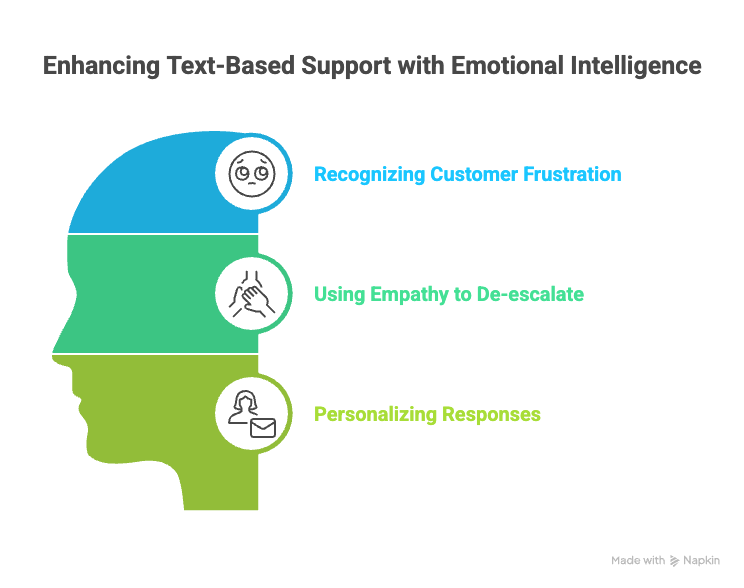
Here's the thing — reading emotions through text is like trying to hear someone's tone through a handwritten letter. About 96% of consumers ranked empathy as one of the most important factors in positive customer support. Without voice inflection or facial expressions, your chat agents face a unique challenge.
4. Recognizing customer frustration without voice cues
When customers type instead of talk, their emotions show up in different ways. Chat agents have to become detectives, paying close attention to word choice and how quickly someone responds.
Watch for these frustration signals:
- Short, clipped sentences
- Multiple messages sent back-to-back
- Excessive punctuation or ALL CAPS
- Loaded words like "ridiculous" or "unacceptable"
- Radio silence after rapid-fire messages
Catching these early means you can shift your approach before a small problem becomes a big one. Customer frustration is pretty common, especially when issues get complex or expectations run high. The best chat agents develop an instinct for spotting emotional undercurrents in seemingly normal text.
5. Using empathy to de-escalate tense situations
Once you spot an upset customer, empathy becomes your best tool. Real emotional intelligence means managing your own reactions while tuning into theirs.
Here's what works: acknowledge their frustration and validate how they're feeling. Skip generic phrases like "I understand" — they can sound hollow. Try something more specific like "I hear you" or "I can only imagine how upsetting that is".
Start with a genuine acknowledgment: "I'm sorry to hear about this". That simple recognition shows empathy right away and tells customers you're taking their issue seriously.
Stay calm under pressure — it's crucial in high-stress chat environments. Your natural instinct might be to get defensive with angry customers, but that just makes things worse.
6. Personalizing responses to build trust
Nobody wants to feel like they're chatting with a robot. Customers reach out because they need human connection, not canned responses. Smart agents read between the lines — they pick up on whether someone's positive, negative, or neutral. Then they match that energy appropriately.
Pay attention to how customers write and mirror their communication style. Use language they can relate to, make things right, and treat them with respect — they'll respect you back.
Don't let personalization stop at using someone's name. Reference their specific situation, acknowledge what they've been through, and end with a clear next step. These small touches make all the difference.
The kiss of death for chat support? Long wait times and impersonal interactions. When response times drag on, customers lose confidence and feel ignored. Keep conversations flowing naturally — no one should wait two minutes wondering if you're still there.
Go beyond just saying "I see the problem." Repeat back what they've told you in your own words to show you really get it. Once you understand their concern, move toward solutions while keeping them updated along the way.
These aren’t nice-to-have chat support skills — they’re what make it work
Advanced chat support skills for high-volume environments
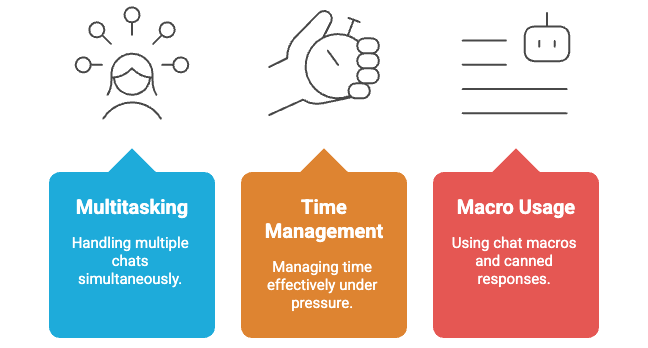
Picture this: your chat queue is lighting up, customers are waiting, and you're trying to help three people at once. Sound familiar? Support teams spend an average of 10 hours and 26 minutes per day chatting with customers, so mastering high-volume skills isn't optional — it's survival.
7. Multitasking across multiple chats
Here's the thing about juggling multiple conversations — most people think they're better at it than they actually are. During interviews, everyone claims they're multitasking masters. Then they hit the floor and realize managing several customers while checking databases and consulting colleagues is way harder than it looks.
The agents who actually succeed don't just wing it. They develop systems:
- Figure out which chats will be quick wins versus complex problems
- Never grab multiple difficult conversations at the same time
- Use tools that show customer history so you're not starting blind
- Track response times so no one gets forgotten
Most experts suggest starting with three concurrent chats max per agent. It's about finding that sweet spot where you're efficient without dropping the ball.
8. Time management under pressure
When the volume hits, everything changes. You need speed, but not at the cost of accuracy. Nobody wins when you rush through responses and create bigger problems.
Smart agents prioritize ruthlessly. Instead of just working through chats in order, they tackle urgent issues first and organize by what actually matters. Create a workspace that works — strip away distractions and keep only what you need visible. Some chat platforms are built specifically to help agents focus without all the extra noise.
Even when you're swamped, always acknowledge new chats right away. Something like "I'm checking this for you now! I'll have an answer in just a moment" keeps people from wondering if you've disappeared.
9. Using chat macros and canned responses effectively
Canned responses can be your best friend or your worst enemy. Used right, they help you respond faster, stay consistent with your brand, and nail those common questions. Used wrong, and customers feel like they're talking to a robot.
The trick? Personalization. Take those standard responses and make them human — add names, order numbers, specific details. Well-crafted templates help you deliver speed without losing the personal touch.
Treat these responses like starting points, not finished products. Different customers need different approaches, so tweak your templates to fit the situation. You get the efficiency boost while keeping that human connection customers actually want.
Bottom line: the best chat agents aren't just fast — they're smart about being fast. Focus on customer satisfaction over pure speed, and you'll see better results across the board.
Problem solving and product knowledge in real-time
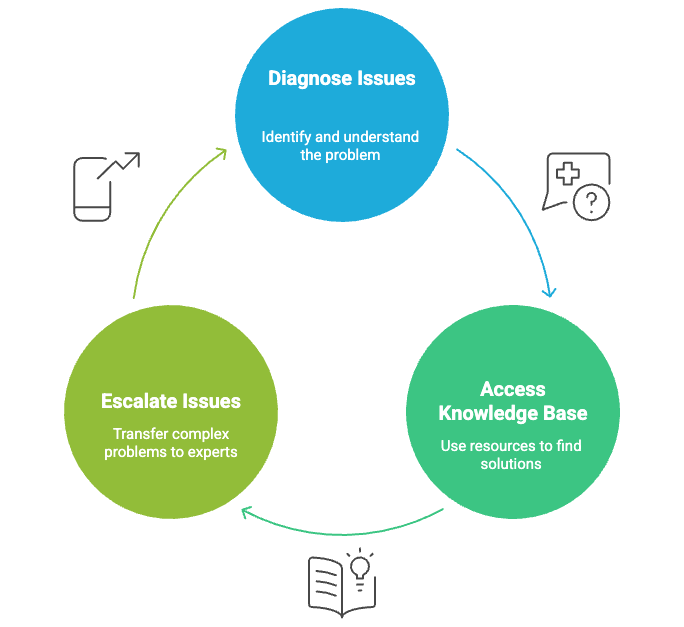
Here's the thing about chat support — you're basically a detective working with limited clues. Your ability to figure out what's really wrong and fix it fast makes the difference between a happy customer and one who never comes back.
10. Diagnosing issues through chat
Good chat agents don't just respond to what customers type — they read between the lines. The ability to interpret a customer's inquiry correctly, analyze the problem, and ask targeted questions to identify root causes is fundamental to providing accurate solutions.
Chat diagnosis is trickier than phone support. You can't hear the frustration in someone's voice or catch those little pauses that reveal what they're really struggling with. Instead, you need to pay close attention to word choice, what they're not saying, and the patterns in their messages.
Here's what separates the pros from everyone else:
- They read every message completely before typing back
- They ask the right follow-up questions when details are missing
- They recognize patterns from similar issues they've seen before
- They dig deeper than surface symptoms to find the real problem
When customers get accurate answers without being bounced around between departments, their satisfaction shoots up dramatically. It's worth the extra effort to get it right the first time.
11. Accessing and using knowledge bases
A solid knowledge base is like having a really smart coworker who never takes a lunch break. Internal knowledge bases provide quick access to product guides, troubleshooting steps, and solutions to common problems. Having all that information centralized means your team delivers consistent, accurate responses every time.
The payoff is huge:
- Problems get solved faster without needing to ask around
- Everyone gives the same helpful answers
- More issues get resolved on the first try
- Customers can find self-service solutions when they want to
Even with AI tools handling more routine tasks, human agents still need deep product knowledge.
The key is knowing your knowledge base inside and out. Train your team to search, find, and use information quickly without making customers sit there waiting. Being able to pull up the right answer while keeping the conversation flowing — that's a skill worth developing.
12. When to escalate and how to do it smoothly
Sometimes you hit a wall. Even with great problem-solving skills and access to all the right information, certain situations need someone with more authority or expertise.
Escalate when:
- The customer asks to speak with a manager
- You've tried multiple approaches and nothing's working
- The solution they want is beyond what you can approve
- The customer becomes threatening or abusive
Here's what frustrates customers more than anything: getting passed around from agent to agent. Nobody wants to explain their problem three times to three different people. That's why chat agents should handle most issues on their own, and frequent escalations usually point to training gaps that need fixing.
When you do need to escalate, don't just dump the chat on someone else. Explain to the customer why you're bringing in help and how it benefits them. Something like "I'm connecting you with a specialist who can approve that refund right away" sets the right expectation.
The goal isn't to avoid escalations completely — it's to make them feel seamless when they happen. Acknowledge the issue, try your best first, then smoothly hand things off while keeping the customer's trust intact.
Technical proficiency and tool mastery
Your chat agents can't wing it when it comes to the technical side. High-performing companies are more likely to use AI-powered chatbots to help with agent workflow. The agents who master their tools are the ones who can actually help customers instead of fumbling around looking for answers.
13. Navigating customer service and chat platforms
Technical proficiency with contact center systems and chat platforms allows agents to retrieve customer data quickly and troubleshoot issues with minimal delays. Here's what your agents need to know cold:
- How to accept and route chat requests
- Where to find and send canned responses
- How to transfer chats to relevant team members
- When to use features like chat transcript exports
Think of it like this: if your chat software is a toolbox, your agents need to know where every tool lives. Comprehensive knowledge of live chat functionality significantly facilitates agent workflow and helps deliver first-class service. Customers can tell the difference between an agent who knows their system and one who's still figuring it out.
14. Using AI suggestions and agent assist tools
AI Agent Assist provides real-time guidance to customer care representatives, helping them resolve issues faster and with greater accuracy. These tools work like having an expert looking over your shoulder, offering:
- Ready-to-send responses based on customer queries
- Answers pulled straight from your knowledge base
- Conversation transcripts and automated summaries
Live chat agent training for new tools
Effective tool training requires different approaches. Live training sessions with specialists facilitate asking questions and building software familiarity. Creating a sandbox environment where agents can practice without pressure helps build confidence.
Pairing new agents with experienced mentors creates a buddy system that fosters collaborative learning. Hands-on lab sessions let agents practice navigating systems in real-world scenarios.
Here's what matters most: the effectiveness of agents correlates directly with providing them the right tools. Regular practice sessions and updates on new features ensure continuous improvement in technical proficiency. Your agents need to stay sharp on the tools that help them help customers.
Conclusion
Chat support isn't going anywhere — your customers have already decided it's how they want to connect with you. The agents who master these chat support skills? They're the ones turning frustrated customers into loyal ones.
Here's the thing: you can't fake good chat support. Customers can tell the difference between an agent who really gets it and one who's just going through the motions. The best agents combine sharp technical skills with genuine human connection. They know when to use a quick macro and when to write something from scratch.
We've covered a lot of ground here — from reading emotional cues in plain text to juggling multiple conversations without dropping the ball. But it all comes down to this: your customers want to feel heard and helped, fast.
The companies getting this right aren't just checking a box. They're seeing real results — better satisfaction scores, customers who stick around longer, and more revenue per chat. That's what happens when you invest in people who know how to turn a simple "Can you help me?" into a conversation that builds trust.
Your chat team is often the first real human contact customers have with your business. Make it count. Give them the skills, the tools, and the authority to solve problems.
Because at the end of the day, behind every chat message is a person who just wants their issue resolved by someone who cares enough to do it right.
The 14 essential chat support skills
Live chat has become the dominant support channel as customers demand instant, convenient assistance. The gap between average and exceptional agents comes down to mastering essential chat support skills that combine speed, empathy, and technical expertise.
- Clear, concise writing that delivers solutions without overwhelming customers
- Reading emotional cues through text alone by spotting frustration in word choice and patterns
- Juggling multiple conversations while maintaining personalized, human connections
- Real-time problem-solving and smooth escalation handling
- Mastering AI-powered tools that enhance human judgment
- Navigating Customer service platforms effortlessly to deliver first-contact resolutions
The most valuable chat support skills go beyond quick responses—they create trust-building experiences that keep customers coming back. Agents who combine technical proficiency with genuine empathy transform simple exchanges into meaningful interactions.
Companies investing in these chat support skills see tangible results through higher conversion rates, increased revenue per chat, and loyal customers who return consistently.
Behind every chat message is someone seeking genuine help, and agents equipped with the right skills turn those moments into opportunities for lasting relationships and business growth.
Frequently Asked Questions
A live chat support job involves assisting customers in real time through online chat platforms. Agents answer questions, resolve issues, provide product or service guidance, and ensure a positive customer experience—all while maintaining speed, accuracy, and professionalism.
Key Responsibilities Include:
- Responding to customer inquiries via live chat.
- Troubleshooting problems and providing solutions.
- Escalating complex issues to the right teams.
- Using AI tools or templates to handle repetitive queries efficiently.
- Maintaining records of conversations and updating tickets.
- Ensuring customer satisfaction and following brand guidelines.
- Morning Prep: Log in, review pending chats, check product updates, and join team huddles.
- Peak Hours: Handle multiple live chats simultaneously—answer questions, troubleshoot issues, and escalate complex cases.
- AI Assistance: Let AI manage routine queries, freeing agents for high-value or nuanced conversations.
- Collaboration: Coordinate with other teams (billing, tech, product) for problem resolution.
- Customer Experience: Keep all interactions friendly, personalized, and aligned with brand tone.
- End-of-Day Wrap-Up: Close resolved chats, follow up on pending tickets, and review performance metrics for continuous improvement.
Key skills required in customer handling
- Effective Communication: Clearly explain solutions, listen actively, and adapt tone to the customer.
- Empathy: Understand customer emotions, show patience, and respond with care.
- Problem-Solving: Quickly analyze issues and offer accurate, practical solutions.
- Product Knowledge: Be well-versed in your company’s products or services to guide customers confidently.
- Time Management: Handle multiple requests efficiently without compromising quality.
- Adaptability: Stay flexible when dealing with different customer personalities or unexpected situations.
- Conflict Resolution: Calmly manage complaints and turn negative experiences into positive outcomes.
- Attention to Detail: Accurately record customer interactions and follow up as needed.
- Technical Skills: Use CRM, chat tools, or ticketing software efficiently.
- Positive Attitude: Maintain professionalism and enthusiasm, even under pressure.
Tips to reduce first response time (FRT) in live chats
- Use AI-Powered Auto Replies: Let AI handle routine questions instantly, so customers get a response the moment they start a chat.
- Pre-Built Response Templates: Save common answers and allow agents to send them quickly instead of typing from scratch.
- Prioritize Incoming Chats: Implement a system that flags new chats or high-priority queries for immediate attention.
- Staff Appropriately During Peak Hours: Analyze traffic patterns and ensure enough agents are online when chat volume is high.
- Train Agents Efficiently: Equip your team with product knowledge, shortcuts, and best practices to resolve queries faster.
- Enable Chat Routing: Direct chats to the right agent or department automatically to prevent delays.
- Monitor Performance Metrics: Track FRT and identify bottlenecks or slow-response patterns for continuous improvement.
